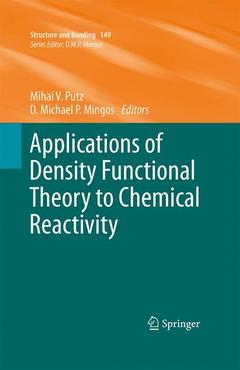Description
Applications of Density Functional Theory to Chemical Reactivity, 2012
Structure and Bonding Series, Vol. 149
Coordinators: Putz Mihai V., Mingos D. Michael P.
Language: English
Subject for Applications of Density Functional Theory to Chemical...:
Publication date: 06-2015
Support: Print on demand
Publication date: 01-2013
189 p. · 15.5x23.5 cm · Hardback
Description
/li>Contents
/li>Comment
/li>
The individual volumes in the series are thematic. The goal of each volume is to give the reader, whether at a university or in industry, a comprehensive overview of an area where new insights are emerging that are of interest to a larger scientific audience. Thus each review within the volume critically surveys one aspect of that topic and places it within the context of the volume as a whole. The most significant developments of the last 5 to 10 years should be presented using selected examples to illustrate the principles discussed. A description of the physical basis of the experimental techniques that have been used to provide the primary data may also be appropriate, if it has not been covered in detail elsewhere. The coverage need not be exhaustive in data, but should rather be conceptual, concentrating on the new principles being developed that will allow the reader, who is not a specialist in the area covered, to understand the data presented. Discussion of possible future research directions in the area is welcomed. Review articles for the individual volumes are invited by the volume editors.
Readership: research scientists at universities or in industry, graduate students
Special offer
For all customers who have a standing order to the print version of Structure and Bonding, we offer free access to the electronic volumes of the Series published in the current year via SpringerLink.
From the Contents: Density Functional Theory of Bose-Einstein Condensation: Road to Chemical Bonding Quantum Condensate - Information Theory Insights into Molecular Electronic Structure and Reactivity - Applying Conventional Ab Initio and Density Functional Theory Approaches to Electric Property Calculations. Quantitative Aspects and Perspectives - Descriptors as Probes for Inter-Molecular Interactions and External Perturbation - Application of Reactivity Indices Within Density Functional Theory to Rationale Chemical Interactions
This series presents critical reviews of the present position and future trends in modern chemical research concerned with chemical structure and bonding
Short and concise reports, each written by the world's renowned experts
Still valid and useful after 5 or 10 years
More information as well as the electronic version of the whole content available at: springerlink.com




